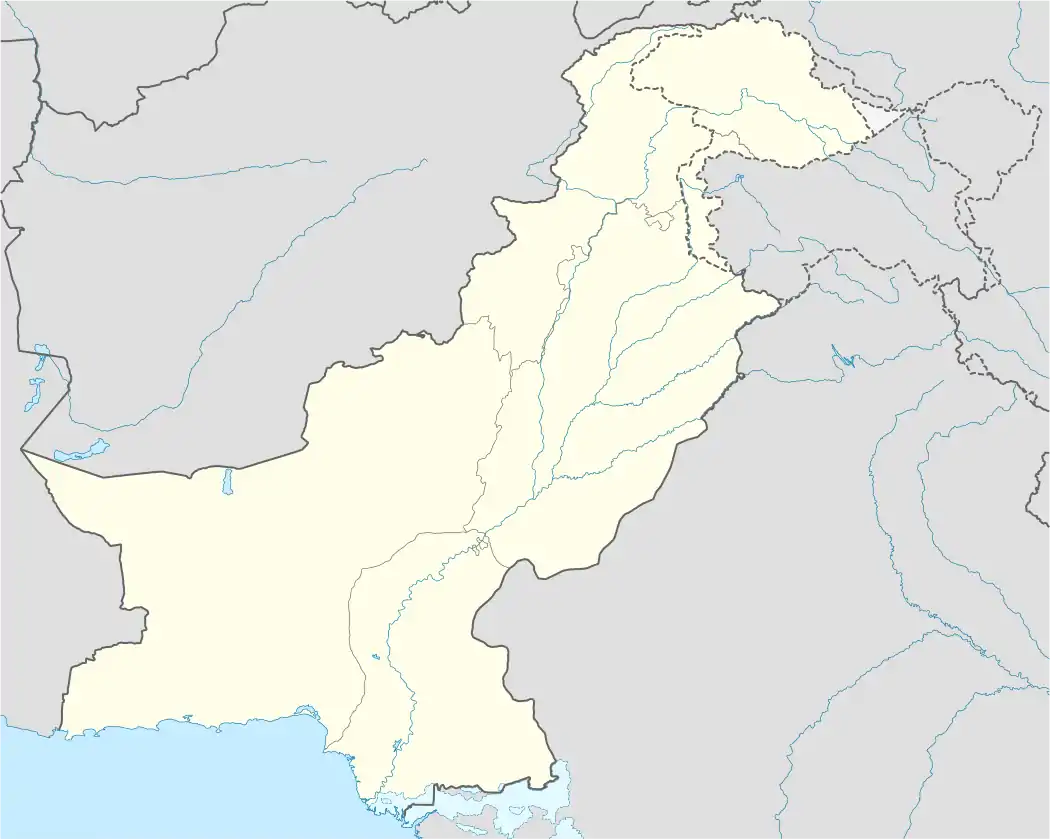 Karachi 41.5 °C (106.7 °F) Lahore 45 °C (113 °F) Larkana 51 °C (124 °F) Rahim Yar Khan 47 °C (117 °F) Multan 45 °C (113 °F) Nawabshah 44.5 °C (112.1 °F) A map marking significantly affected cities | |
| Start date | April 2017 |
|---|---|
| End date | April 2017 |
| Losses | |
| Deaths | At least 4 as of 5 May 2017[1] |
In April 2017, a severe heat wave with temperatures as high as 51 °C (124 °F) hit Pakistan, especially its southern parts.[2][3] This heat wave broke the old temperature records of many cities in the country for the month of April.[4] Larkana, a city in the southern province of Sindh, experienced the highest maximum temperature of 51.0 °C on 20 April,[5] breaking the previous day's record of 50 °C.[6]
Affected areas
In late March 2017, a heatwave engulfed most parts of the Sindh province as Nawabshah and Larkana registered 43 °C.[2]
The severe heat wave turned April 2017 as the hottest April passed during the last two decades. On 17 April, Sukkur recorded 47 °C breaking its earlier record of 46.5 °C on 25 April 2000. The temperature in Multan reached 45.1 °C which broke its previous record during the month of April of 44.7 °C recorded on 19 April 2010. Similarly, Khanpur leveled its previous maximum temperature of 46.5 °C recorded on 27 April 1993. In Faisalabad, maximum temperature reached 44.5 °C compared to its previous maximum temperature of 44 °C recorded on 29 April 2007.[7]
On 19 April, four Pakistani cities witnessed the hottest days of their history in the month of April, including Larkana (50 °C), Moenjo Daro (49 °C), Sibi (49 °C) and Lahore (45 °C).[6] Previously, the maximum temperature recorded in Lahore during April was 44 °C on 18 April 2010.[7] On 20 April, Larkana recorded 51 °C as maximum temperature, while the meteorological office at Moenjodaro Airport recorded the temperature at 50 °C.[5] On 21–22 April, dust storms and light rain over upper parts of the country and in north-east Punjab broke the heat spell but damaged wheat and other crops.[8]
However, most parts of Sindh continued to experience an early summer. On 1 May, Nawabshah and Mithi recorded the maximum temperature of 44.5 °C.[9] On 5 May, the heat wave claimed four lives in Hyderabad which recorded temperature at 45 °C.[1]
Recorded temperatures
Extreme temperatures started to affect parts of the country from mid-April and peaked on 19–20 April.
| Place | Temperature | Date |
|---|---|---|
| Larkana | 51.0 °C (123.8 °F) | 20 April[5] |
| Sukkur | 47.0 °C (116.6 °F) | 17 April[7] |
| Moenjo Daro | 50.0 °C (122.0 °F) | 20 April[5] |
| Karachi | 41.5 °C (106.7 °F) | 30 April[9] |
| Lahore | 45.0 °C (113.0 °F) | 19 April[6] |
| Nawabshah | 44.5 °C (112.1 °F) | 1 May[9] |
| Multan | 45.1 °C (113.2 °F) | 17 April[7] |
| Sibi | 49.0 °C (120.2 °F) | 19 April[6] |
| Rahimyar Khan | 47.0 °C (116.6 °F) | 17 April[7] |
| Khanpur | 46.5 °C (115.7 °F) | 17 April[7] |
See also
References
- 1 2 "Heat wave claims four lives in Hyderabad". Pakistan Observer. Associated Press of Pakistan. 5 May 2017. Archived from the original on 10 May 2017. Retrieved 16 May 2017.
- 1 2 "Severe heatwave engulfs most parts of Sindh". Pakistan Today. Associated Press of Pakistan. 29 March 2017. Retrieved 16 May 2017.
- ↑ "Heatwave builds across northern India and Pakistan". Al Jazeera English. 15 April 2017. Retrieved 16 May 2017.
- ↑ Pakistan Meteorological Department
- 1 2 3 4 "Heatwave continues in Larkana". The Nation (Pakistan). Associated Press of Pakistan. 21 April 2017. Retrieved 16 May 2017.
- 1 2 3 4 Bhatti, M. Waqar (20 April 2017). "Larkana's temperature touches 50°C". The News International. Retrieved 16 May 2017.
- 1 2 3 4 5 6 Raza, Ali (18 April 2017). "Lahore baking in hottest April since 1993". The News International. Retrieved 16 May 2017.
- ↑ Hanif, Intikhab (23 April 2017). "Dust storms break heat spell but damage crops". Dawn. Retrieved 16 May 2017.
- 1 2 3 "Mercury shoots up to 44.5°C in Nawabshah, Mithi". Dawn. 2 May 2017. Retrieved 16 May 2017.